Related Research Articles

A seed is an embryonic plant enclosed in a protective outer covering. The formation of the seed is part of the process of reproduction in seed plants, the spermatophytes, including the gymnosperm and angiosperm plants.

Sowing is the process of planting seeds. An area or object that has had seeds planted in it will be described as a sowed area.

Germination is the process by which an organism grows from a seed or spore. The term is applied to the sprouting of a seedling from a seed of an angiosperm or gymnosperm, the growth of a sporeling from a spore, such as the spores of fungi, ferns, bacteria, and the growth of the pollen tube from the pollen grain of a seed plant.

A seedbed or seedling bed is the local soil environment in which seeds are planted. Often it comprises not only the soil but also a specially prepared cold frame, hotbed or raised bed used to grow the seedlings in a controlled environment into larger young plants before transplanting them into a garden or field. A seedling bed is used to increase the number of seeds that germinate.
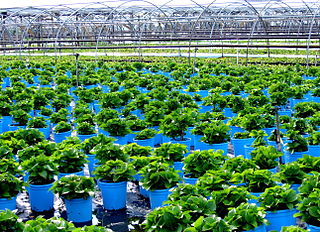
A nursery is a place where plants are propagated and grown to a desired size. Mostly the plants concerned are for gardening, forestry or conservation biology, rather than agriculture. They include retail nurseries, which sell to the general public, wholesale nurseries, which sell only to businesses such as other nurseries and to commercial gardeners, and private nurseries, which supply the needs of institutions or private estates. Some will also work in plant breeding.

Plant propagation is the process by which new plants grow from a variety of sources: seeds, cuttings, and other plant parts. Plant propagation can also refer to the man-made or natural dispersal of seeds.
Silviculture is the practice of controlling the growth, composition/structure, and quality of forests to meet values and needs, specifically timber production.

Chitosan is a linear polysaccharide composed of randomly distributed β-(1→4)-linked D-glucosamine and N-acetyl-D-glucosamine. It is made by treating the chitin shells of shrimp and other crustaceans with an alkaline substance, such as sodium hydroxide.

Ziziphus mauritiana, also known as Indian jujube, Indian plum, Chinese date, Chinese apple, and dunks is a tropical fruit tree species belonging to the family Rhamnaceae. It is often confused with the closely related Chinese jujube, but whereas Z. jujuba prefers temperate climates, Z. mauritiana is tropical to subtropical.
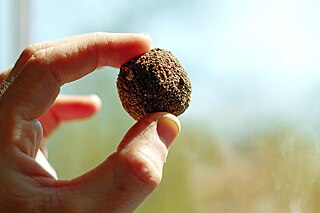
Seed balls, also known as earth balls or nendo dango, consist of a variety of different seeds rolled within a ball of clay, preferably volcanic pyroclastic red clay. Various additives may be included, such as humus or compost. These are placed around the seeds, at the center of the ball, to provide microbial inoculants. Cotton-fibres or liquefied paper are sometimes mixed into the clay in order to strengthen it, or liquefied paper mash coated on the outside to further protect the clay ball during sowing by throwing, or in particularly harsh habitats.
Winter sowing is a method of starting seeds outdoors in winter. This is generally done with seeds that require a period of cold stratification. The method takes advantage of natural temperatures, rather than artificially refrigerating seeds.
Seed dormancy is an evolutionary adaptation that prevents seeds from germinating during unsuitable ecological conditions that would typically lead to a low probability of seedling survival. Dormant seeds do not germinate in a specified period of time under a combination of environmental factors that are normally conducive to the germination of non-dormant seeds.

Erythrina mulungu (Mulungu) is a Brazilian ornamental tree and medicinal plant native to the cerrado and caatinga ecoregions in Brazil, South America.
Nano seed priming in botany and agriculture is a form of seed planting preparation in which the seeds are pre-soaked in nanoparticle solution. Seeds are considered to be an important part of crop life cycle as it influences the propagation of critical phases like germination and dormancy. Seed priming before sowing is considered to be one of the promising ways to provide value-added solutions to maximize the natural potential of seed to set the plant for maximum yield potential with respect to both quality and quantity. Positive effect on the shoot and root growth of seedlings of wheat when treated with iron-oxide nanoparticles. This innovative cost-effective and user-friendly method of biofortification has proven to increase grain iron deposition upon harvesting. Hence, the intervention of nanotechnology in terms of seed priming could be an economical and user-friendly smart farming approach to increase the nutritive value of the grains in an eco-friendly manner.

Damping off is a horticultural disease or condition, caused by several different pathogens that kill or weaken seeds or seedlings before or after they germinate. It is most prevalent in wet and cool conditions.

Urocystis agropyri is a fungal plant pathogen that causes flag smut on wheat.
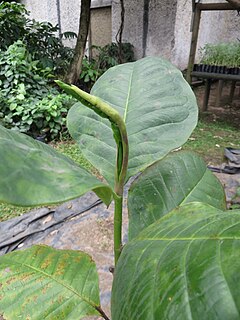
Magnolia yarumalense is a species of plant in the family Magnoliaceae. It is endemic to Colombia. Common names include: Gallinazo morado, gallinazo, boñigo (Barbosa), almanegra.
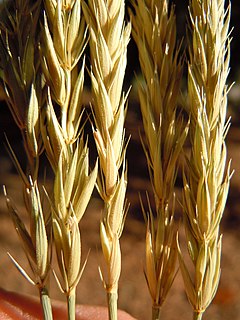
Psathyrostachys juncea is a species of grass known by the common name Russian wildrye. It was formerly classified as Elymus junceus. It is native to Russia and China, and has been introduced to other parts of the world, such as Canada and the United States. Psathyrostachys juncea is a great source of food for grazing animals, as it has high nutrition value in its dense basal leaves, even in the late summer and autumn seasons. This species can grow and prosper in many harsh environments, making it an ideal candidate for improvement as it can grow in areas were farming is difficult. This species is a drought-resistant forage plant and can survive during the cool seasons. It is also a cross-pollinator and is self-sterile. This means that P. juncea cannot self-fertilize; it must find another plant of the same species with which to exchange gametes. Self-sterilization increases the genetic diversity of a species.
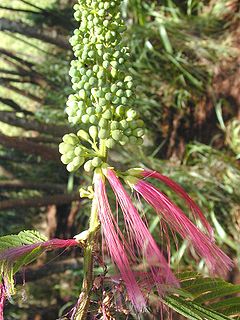
Calliandra calothyrsus is a small leguminous tree or large shrub in the family Fabaceae. It is native to the tropics of Central America where its typical habitat is wet tropical forests or seasonally dry forests with a dry season of four to seven months, when it may become deciduous. This tree grows to about 6 m (20 ft) and has pinnate compound leaves and flowers with a boss of prominent reddish-purple stamens. It is not very drought-tolerant and the above-ground parts are short-lived but the roots regularly resprout.
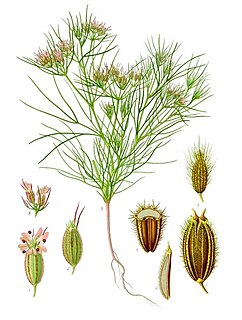
Cumin is a flowering plant in the family Apiaceae, native to the Irano-Turanian Region. Its seeds – each one contained within a fruit, which is dried – are used in the cuisines of many cultures in both whole and ground form. Although cumin is thought to have uses in traditional medicine, there is no high-quality evidence that it is safe or effective as a therapeutic agent.
References
- ↑ Black, Michael H.; Halmer, Peter (2006). The encyclopedia of seeds: science, technology and uses . Wallingford, UK: CABI. pp. 224. ISBN 978-0-85199-723-0.
- ↑ http://www.ag.ohio-state.edu/~seedbio/HCS631_files/11B%20Seed%20Enhancements%20%28for%20class%29.pdf [ dead link ]